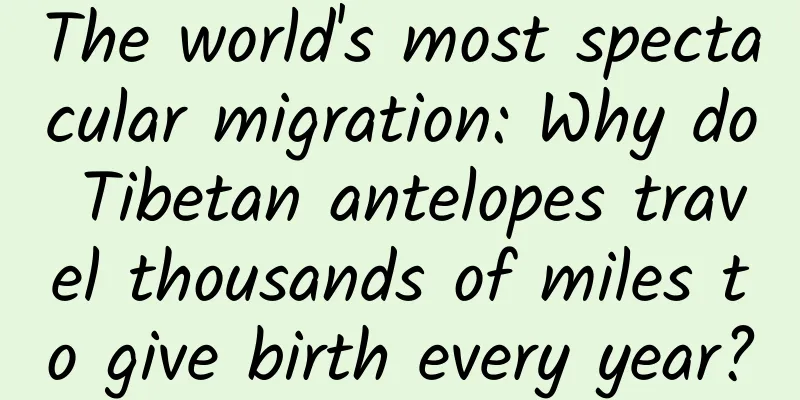The world's most spectacular migration: Why do Tibetan antelopes travel thousands of miles to give birth every year?

|
Science Times reporter Zhang Yun The famous annual scene is here! On May 7, in the "forbidden zone of life" Hoh Xil, groups of Tibetan antelopes set out on a thousand-mile journey, crossing the Qinghai-Tibet Railway and Qinghai-Tibet Highway to the "big delivery room" Zhuonai Lake and Taiyang Lake to "give birth" together. The migration of Tibetan antelopes is one of the three most spectacular migrations of ungulates in the world. From May to August every year, female Tibetan antelopes from different regions of the Qinghai-Tibet Plateau gather in groups and go to birthing grounds thousands of miles away to give birth, and then return with their lambs along the same route, completing the migration journey of life. Why do Tibetan antelopes migrate for generations? How do they choose their migration routes? And how do they "navigate" to their destinations? "The migration patterns of Tibetan antelopes have always been a blank in the field of international wildlife research." Wu Xiaomin, a researcher at the Shaanxi Institute of Zoology, said in an interview with the Popular Science Times on May 9 that since 2013, he and his team have been equipping Tibetan antelopes in Qinghai's Hoh Xil and Tibet's Qiangtang with Beidou satellite positioning systems, genetic diversity, and air-space integration research to record the migration routes and migration times of Tibetan antelopes in order to uncover the mystery of Tibetan antelope migration, and the research is still in progress. "Up to now, all the motivations for the migration of Tibetan antelopes in the industry are mostly guesses and assumptions, and there is no conclusion." Wu Xiaomin said. Chen Jiarui, an associate professor at Qinghai University, and her research team are engaged in the protection of wildlife on the Qinghai-Tibet Plateau, and the adaptation and evolution of plateau animals. She told reporters that the main reasons for the migration of Tibetan antelopes are to avoid solid precipitation, nutrition, parasites, and paleoclimate and environmental driving theories. "At present, our research team has proposed the paleoclimate and environmental driving theory, that is, the migration behavior is the collective memory formed by the Tibetan antelopes in the process of adapting to the long-term geological and historical climate events of the Qinghai-Tibet Plateau." From killing to rebirth, from endangered to vulnerable, protecting Tibetan antelopes has become a consensus of mankind. Wu Xiaomin said that the number of Tibetan antelopes once dropped from millions in the prosperous period to 60,000 to 70,000 in the 1980s and 1990s. After decades of unremitting efforts to protect the population and restore the habitat, the number of Tibetan antelopes on the Qinghai-Tibet Plateau has recovered to more than 300,000 today. "Some net fences that may affect the safe passage of Tibetan antelopes have been removed from the migration corridors of Tibetan antelopes on the Qinghai-Tibet Plateau. Tibet has implemented the relocation of Tibetan antelope habitats, and the "bridge instead of road" of the Qinghai-Tibet Railway has made way for Tibetan antelopes. These measures aim to clear all factors that hinder the migration of Tibetan antelopes and enable ewes to return with their lambs smoothly." After years of research, Wu Xiaomin and his team have achieved a series of interim research results in the accurate migration time and route of Tibetan antelopes, migration distance and daily migration distance, arrival and departure time of the birthing grounds, as well as the activity range of Tibetan antelopes in the birthing grounds, habitats and the ecological environment status of the birthing grounds. However, there are still many unsolved mysteries about the "plateau elves". Experts believe that the migration of Tibetan antelopes is a special scientific issue. Unlike the migration of birds, insects or African grassland animals, the particularity of the species itself and its living environment makes it very difficult for scientific researchers to study it. |
<<: Where do the elements on the periodic table come from?
Recommend
SMMT: UK new car registrations fell 4.4% in September 2020
The UK new car market fell 4.4% in September, acc...
Mimi Meng, Visual Magazine, and other big names will teach you how to come up with titles!
I wonder if you have ever encountered this situat...
Does Huang Xiaoming’s Nut Projector P1 have the same looks as Angelababy?
Last month, the JMGO Projector P1, invested by St...
A woman pulled a "string" along the way after eating mushrooms. She said that if you eat mushrooms, you will eat the soul of the mushrooms. You can't eat mushrooms randomly!
Recently, we often see news about people who have...
WeChat marketing precise traffic generation techniques and methods! How to attract targeted fans on WeChat?
I have collected some learning materials on Inter...
The fragrance of jasmine and the stench of poop are actually the same smell component, can you believe it!
The sense of smell is one of the most important s...
Can Alibaba really monopolize the “Overseas Shopping” trademark?
More than 88% of “sea shopping” trademarks are ap...
The "body acid-base theory" has been falsified, so is it still meaningful to talk about the "acidity and alkalinity" of food?
Author: Cui Yihui, registered dietitian Reviewer:...
How much does it cost to develop an underwear mini program in Panzhihua?
The launch of mini programs has brought convenien...
How much does it cost to recruit investors for Dingxi's designated driver app?
Dingxi designated driver mini program investment ...
Case Analysis: How to use the AARRR model to increase user growth?
This article takes Luckin Coffee as an example. I...
Help! How come some fish have teeth like humans? | Nature Trumpet
Welcome to the 39th issue of the Nature Trumpet c...
Ghosn may no longer serve as Renault CEO, successor will be found from within
According to foreign media reports, Carlos Ghosn,...
H5 Mobile Debugging Guide
[[406894]] A brief summary: Mobile debugging pain...
Cargo Ship: Please don’t just call me “the courier”
Not long ago, my country used the Long March 7 ca...









